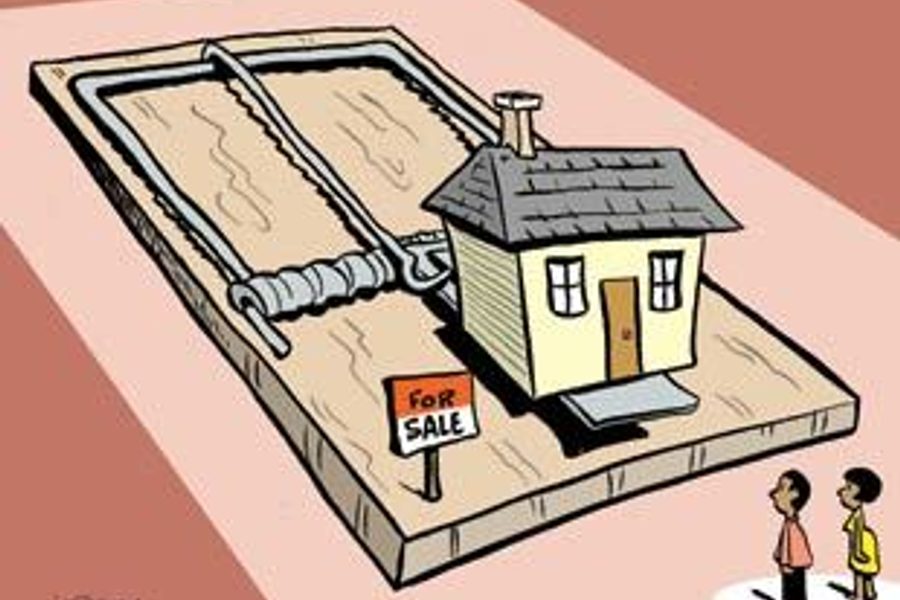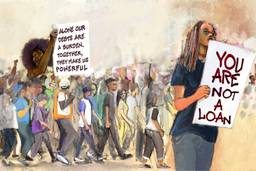The Subprime Bait and Switch
Under the guise of extending home ownership to all, predatory lenders undermine community reinvestment
Alexander Gourse

When the housing market began its rapid ascent in the mid-’90s, many observers waxed rhapsodic about the potential of high-interest, subprime loans to merge the financial interests of investors and low income and minority communities. The hope for subprime boosters was that such loans would allow the mortgage industry to continue business as usual while at the same time meeting government mandates for fair and affordable housing. As recently as April 2005, Alan Greenspan praised the deregulation of the banking and lending industries for having “vastly expanded credit availability to virtually all income classes.”
It’s true that the number of minority homeowners increased at a similar rate to that of all homeowners during the last decade, but the housing market’s recent slump has brought to light serious weaknesses in the subprime model, raising doubts about its viability as a tool for community reinvestment. The Wall Street Journal recently reported that Greenspan’s zeal for deregulation may have caused him to turn a blind eye to predatory practices within the subprime lending industry, and consumer advocates are now predicting that nearly 20 percent of subprime mortgage loans made since 2005 will end in foreclosure, at a loss to the consumer of around $164 billion.
The home mortgage industry divides would-be borrowers into two basic types. Prime borrowers are those who have adequate income and good credit histories. Subprime borrowers are those with problematic credit histories and, often, less-than-adequate incomes. The loans are inherently risky for the lender, as such borrowers are more likely to default on payments, requiring higher interest rates to offset this risk.
Before the mid-’90s, subprime lenders operated on a limited scale, but the rapid growth in the housing market brought with it more mortgage companies that specialized in subprime lending. The subprime industry grew from a $35 billion per year industry in 1994 to more than $330 billion in 2003, and from 2004 to 2006 the volume of subprime loans nearly doubled to more than $600 billion.
“These loans keep being made because investors make a profit,” says Geoff Smith, research director at the Woodstock Institute, a Chicago-based nonprofit that specializes in issues of community economic development. “Investors can tolerate a certain number of losses, because failures are priced into the risk assessment. As long as investors are still profiting, mortgage companies will do whatever they can to make more loans, and to maximize the total sums loaned out.”
While industry representatives have lauded their own success in offering credit to financially underserved populations, recent studies suggest that subprime loans have only a marginal effect on homeownership rates. Original purchase loans comprise only a small portion of subprime mortgages, and an even smaller percentage – about 9 percent – go to first-time homebuyers. A majority of subprime loans are refinances, with homeowners looking to lower their monthly payments or to draw out the equity in their homes to pay off their consumer debt or other personal expenses. If foreclosure rates continue to rise as predicted, the Center for Responsible Lending estimates that though some people will become first time homeowners due to subprime loans, there will be significantly more borrowers that will lose their homes to foreclosure.
Industry representatives typically cite the poor credit histories of most subprime borrowers to explain increasing foreclosure rates. Consumer and community advocates, however, paint a darker picture. “Predatory lending is definitely a systemic problem within the subprime mortgage industry,” says Al Hofeld Jr., a litigation attorney and chair of the South Side Community Federal Credit Union in Chicago (SSCFU). “There are very few subprime lenders who will make a subprime loan where the interest rate actually reflects the risk involved.”
According to Smith, predatory lenders put borrowers into loans that they cannot afford. While blatant fraud, such as the falsification of a borrower’s income to justify a larger loan, is becoming less common, the misrepresentation of a loan’s characteristics, like the concealment of a fixed rate “teaser” period that adjusts upward after two years, is a growing problem.
Hofeld says subprime mortgage companies routinely use bait-and-switch tactics to lure in potential borrowers and maximize the amount of money loaned out. At closing, borrowers are often presented with terms that do not match those previously offered by the company, and then pressured into signing documents which they have not had time to review. Ameriquest Mortgage Company is currently facing hundreds of lawsuits which allege that they routinely baited potential customers by promising fixed interest rates, low or no fees, lower monthly payments, no prepayment penalties, or by representing to borrowers that they qualify for a particular set of terms.
In 2005, Betty and Tyrone Walker, a couple living in the Park Manor neighborhood on the south side of Chicago, took out a refinance loan with Ameriquest. “All we wanted to do was to make our house more livable,” says Walker, who is legally disabled and is raising a 12-year-old adopted daughter on her husband’s salary as a mail clerk at a local medical school. After being solicited by Ameriquest through the mail, the Walkers decided to use some of the equity in their home to refurnish their basement.
The Walkers requested information about the loan numerous times, and were confident that they knew what the terms of the loan would be when they went to sign the closing documents. “We just kept asking them whether we were going to remain on a fixed rate, and they just kept lying to us, telling us we’d get a fixed rate,” Mrs. Walker alleges in a lawsuit against Ameriquest.
As they later discovered, however, the terms of the loan were not as they expected. Not only did the loan have an adjustable rate that can go as high as 13.4 percent, but the Walkers allege that Ameriquest falsely told them that their home had doubled in value since they had bought it a few years earlier, thus qualifying them for a larger loan amount. Ameriquest didn’t give them copies of their loan documents at closing, and as a result the Walkers did not realize that the terms had been changed until well after the three-day period during which they could legally cancel the loan. They have since tried to refinance, but have been unable to find another lender willing to lend them the amount currently owed to Ameriquest; the artificially inflated appraisal value has in effect trapped them in a loan with a rising interest rate.
“I felt so stupid after I realized that I had been taken advantage of,” says Walker. “I made them a lunch! I’m always cooking, so I offered them food. I thought they were doing such a swell job of helping us that I cooked for these people, oh lord.”
The race factor
The Walkers’ story is all too familiar. Predatory lending is a particularly widespread problem in low-income and minority communities, where a complex history of housing discrimination, racial segregation and a lack of access to affordable credit have left borrowers with few options. Though redlining, blockbusting and other discriminatory practices were banned in stages between 1968 and 1977, most banks are reluctant to open branches in black neighborhoods, a vacuum that is filled by currency exchanges, payday lenders and now subprime mortgage companies.
“Subprime lenders,” says Smith, “are taking advantage of the fact that they’re the only game in town.” Individual brokers and loan officers make money by taking “points” – that is, charging percentage points of the loan amount, which are added to the borrower’s closing costs – giving them an incentive to maximize the loan amount, regardless of the borrower’s ability to pay for it.
According to “Paying More for the American Dream,” a joint report from six national housing policy organizations, in 2005, black borrowers were 3.8 times more likely than whites to be placed in a high cost loan, while Hispanic borrowers were 3.6 times more likely than whites to receive such a loan. Income disparities between white and minority communities account for some of this difference, but Smith says the disparity is too large to be accounted for by income alone. Low-income black borrowers in the Chicago area were four times as likely to be put in high cost loans than low-income white borrowers.
—— PAGE SPLIT —–But the largest disparity was in the highest income bracket, where blacks were five times as likely as whites to be placed in a high cost loan. Foreclosure rates in heavily minority neighborhoods across the nation follow these trends, with black and Latino neighborhoods experiencing significantly higher foreclosure rates than their white counterparts.
Regulation and alternatives
Consumer fraud laws, including requirements that lenders disclose the terms of a loan and borrowers’ cancellation rights, have been important tools for attorneys fighting predatory lenders. But with thousands of lawsuits filed on behalf of subprime borrowers across the country, many consumer advocates are calling for government regulation of the subprime industry.
“Ideally, what we need is a federal law to make sure lenders are using appropriate qualifying standards so that borrowers can repay the loans,” says Smith. Groups like the Center for Responsible Lending have also supported a ban on prepayment penalties and a reform of the “perverse compensation incentives” for “hazardous” loan products.
Congress however is unlikely to pass comprehensive legislation that deals with predatory lending, says Smith. “Realistically, we should be focusing on the state laws currently under debate.” In 1999, North Carolina was the first state to regulate predatory lending practices and dozens of other states and municipalities have followed suit. This year alone legislation dealing with subprime and predatory lending has been introduced in 26 states.
Hofeld, however, sees regulation as only a partial solution. “Some of the laws regulating predatory lenders could be improved, but some of the problems we see are very difficult to regulate. You can’t control what salespeople tell prospective borrowers.”
What’s more, warnings from the mortgage industry that regulation will cut off credit to low income and minority neighborhoods have created a panic among some community leaders and politicians. In Illinois, a bill mandating credit counseling for borrowers in several Chicago zip codes was suspended due to fears that it was racist and would slow real estate sales in those areas.
The seemingly no-win choice between disinvestment in low-income communities or allowing predatory lenders to operate freely might not be as bleak as it appears. A network of Community Development Financial Institutions (CDFIs) has emerged in some cities, providing affordable financial services to low-income individuals who might otherwise be prime targets for predatory lenders. Although their resources are limited, such institutions offer an alternative model for low-income community development.
“Our biggest problem is one of scale,” Hofeld says about the SSCFU. “We want to get to the point where we have a large enough number of deposits so that we’re making enough loans to be self sufficient.”
With around 1,800 members and $3 million in assets, the SSCFU serves 33 neighborhoods on the south side of Chicago with a population of approximately 854,000 people. A self-described “financial institution with a social mission,” the SSCFU is one of approximately 225 members of the National Federation of Community Development Credit Unions, a national organization working to establish a financial infrastructure in poor communities and empower low-income people through asset development.
While much of the capital required to operate the SSCFU has come from foundations and member deposits, federal money has been important as well. Established in 1994, the CDFI Fund within the Treasury Department has made resources available for community development to credit unions, banks and microenterprise funds.
“The CDFI Fund really is the single largest source of funding for these institutions,” says Cliff Rosenthal, the executive director for the National Federation of Community Development Credit Unions. “Though they can grow slowly on their own, the Fund is the only source of major investment that allows these institutions to make quantum leaps in their work.”
Since the Bush administration took office, however, the CDFI Fund has decreased by more than 50 percent. As a result, not only is funding harder to come by, but the maximum grants awarded by the Fund have decreased from around $3 million to $585,000.
Despite the lack of resources, community development credit unions like the SSFCU are proving that the usurious practices of predatory lenders are not a necessary evil in the fight for fair and affordable housing.
“The problems in the subprime mortgage industry should be framed as an affordable housing issue,” says Hofeld. “We often compartmentalize the way we think about issues, but I really think that predatory lending is something that is decreasing the supply of affordable housing. And the lack of access to mortgage credit on fair terms is something that prevents people from getting into homes.”







